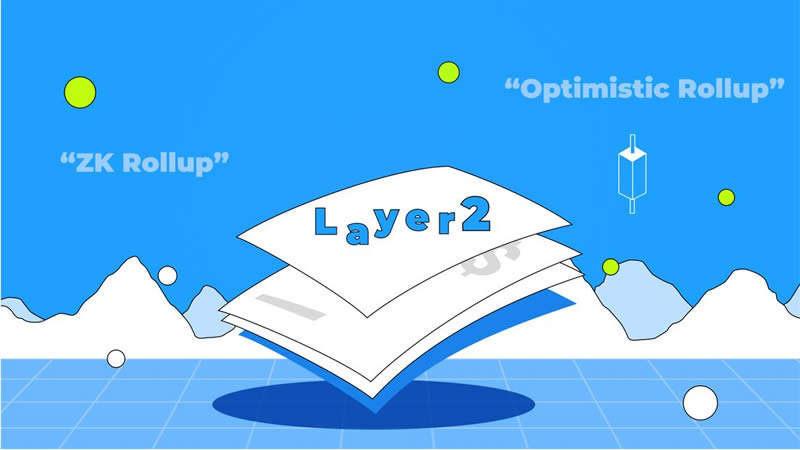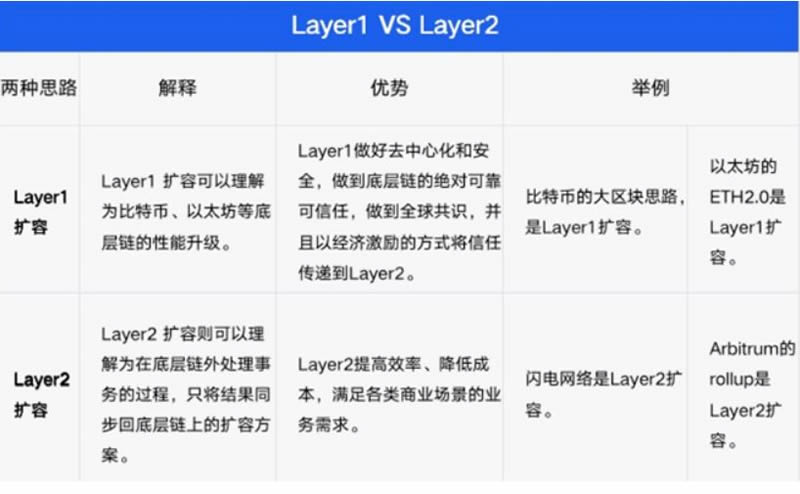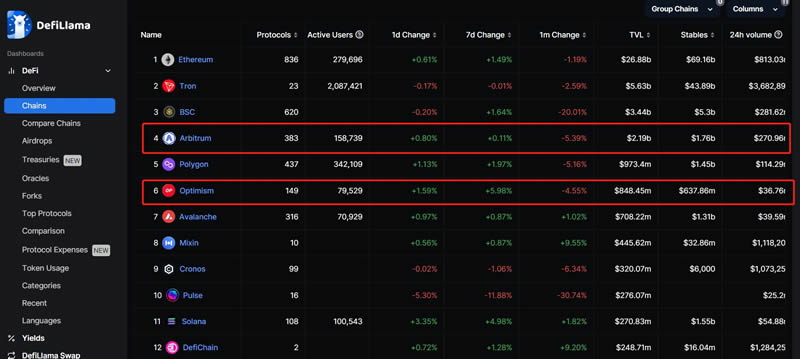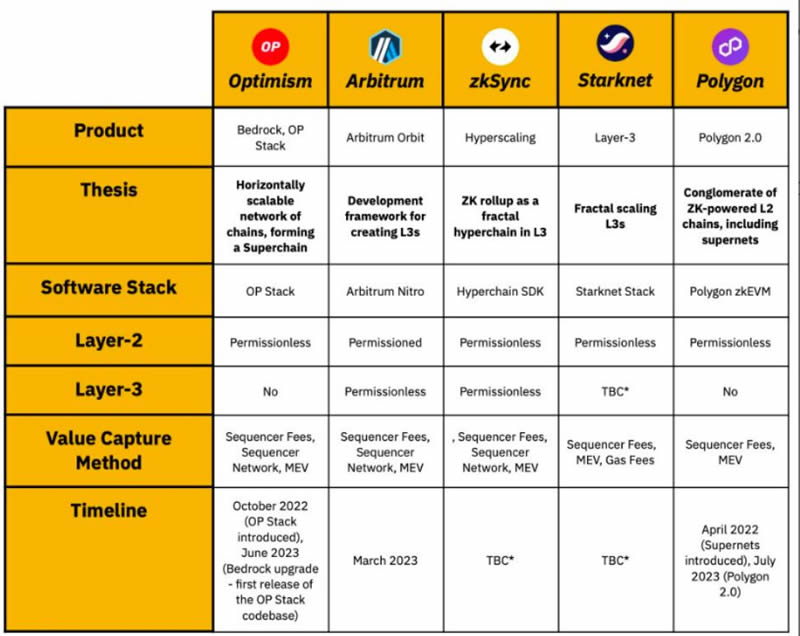What is Layer2? What other leading projects are there for Layer 2?
Summary
php editor Baicao is here to introduce the concept of Layer2 and some leading projects. Layer2 refers to the second layer expansion solution on the Ethereum network, aiming to improve the transaction throughput and scalability of the Ethereum network. Layer 2 technology allows users to obtain higher transaction speeds and lower transaction fees without sacrificing security and decentralization. Currently, some leading Layer 2 projects include Optimism, Arbitrum, zkSync, etc., all of which have achieved Ethereum expansion to varying degrees. In the future, with the continuous development of Layer 2 technology, we are expected to see more innovative projects emerge, bringing more opportunities and challenges to the entire blockchain field.
Compared with the ZK Rollup solution, Optimistic Rollup is easier to implement because of its stronger portability. In addition, under the strong market demand, it also formed a first-mover advantage. In terms of lock-up volume, Optimistic Layer 2 solutions Arbitrum and Optimism have surpassed many previously well-known Layer 1 public chains, ranking fourth and sixth respectively.
Compared with the long withdrawal cycle problem of Optimistic Rollup, ZK Rollup solves this problem through mathematical reliability proof. However, because ZK Rollup is not fully compatible with EVM, its development progress is relatively slow and it has also lost its first-mover advantage to a certain extent.
4.Leading Layer 2 projects include Optimism, Arbitrum, zkSync, Polygon and StarkNet; in addition, well-known Layer 2 projects include Immutable X, Scroll, Loopring, etc.

What is Layer2?
When it comes to Layer2, we need to first understand the expansion issue of Ethereum. Initially, Ethereum aimed to become a programmable blockchain platform, a world computer. However, as the amount of data increases, the Ethereum network has been experiencing congestion problems, which requires Ethereum to have high performance requirements. Therefore, capacity expansion has become the main solution to improve the performance of Ethereum and has also become the focus of market attention. The scaling technology aims to reduce the burden on the Ethereum main chain and improve overall performance by transferring some transactions to side chains or off-chain processing. This approach can increase transaction throughput, lower transaction fees, and reduce congestion issues. Layer2 solutions come in many different forms, such as state channels, sidechains, Plasma, etc. These technologies can reduce the number of transactions on the Ethereum main chain by aggregating transactions into a single transaction, thereby increasing overall efficiency. All in all, there are two expansion routes for Ethereum through the use of Layer 2: on-chain expansion and off-chain expansion. On-chain expansion mainly uses sharding technology, which is one of the core goals of ETH 2.0. However, sharding technology is very difficult to develop. Initially, Ethereum planned to use 1024 shards, but due to technical difficulties, it was decided to reduce it to 64 shards. However, even so, deploying 64 shards still takes a while. Due to the explosion of blockchain applications such as DeFi and NFT, the demand for expansion has become very urgent, so the market has turned its attention to the off-chain expansion solution - Layer 2, which is a less difficult option to implement.
In short, Layer 2 achieves expansion by establishing a new chain next to the main chain. Analogous to a building, Layer 1 is equivalent to expanding the foundation area, while Layer 2 is equivalent to adding floors to an existing building. Their common goals are to increase Ethereum’s scalability, alleviate network congestion, reduce high gas fees, and improve network efficiency. The figure below shows the comparison between Layer1 and Layer2.
 Figure 1: Comparison chart of Layer1 expansion and Layer2 expansion
Figure 1: Comparison chart of Layer1 expansion and Layer2 expansion
To further explore the technical solutions of Layer2, Ethereum Layer2 solutions can be divided into: State channels, sidechains, Plasma, Rollups, Validium, hybrid solutions, etc. The following figure shows the main differences between different technical solutions:
 Figure 2: Comparison of Layer2 specific expansion plans
Figure 2: Comparison of Layer2 specific expansion plans
Among the many Layer2 solutions, the most popular one is currently The focus is on Rollup. Rollup means "summarizing" or "arranging" in Chinese. In the Ethereum network, due to the bandwidth limitations of the ETH network, gas fees usually rise significantly when the network transaction volume is large. The function of Rollup is to copy and send the content that Ethereum needs to calculate to the Layer 2 protocol connected outside Ethereum for calculation. Then, the calculation results are compressed, packaged and re-sent back to the on-chain network. Rollup executes transactions outside Layer1, but publishes transaction data on Layer1. Since transaction data is included in Layer 1 blocks, Rollup is equivalent to inheriting the security of Ethereum. According to different schemes for the effectiveness of compressed data (that is, data correctness), Rollup can be divided into two types: Optimistic Rollup and ZK Rollup.
What are the advantages and disadvantages of Optimistic Rollup
Compared with the ZK Rollup solution, Optimistic Rollup is easier to implement in the short term, mainly because it has stronger portability, which further promotes its formation First mover advantage. Currently, the leading projects based on Optimistic Rollup include Optimism and Arbitrum. These two Layer 2 projects have issued tokens and have initially formed a first-mover advantage. In contrast, projects based on ZK Rollup such as zkSync are developing at a slower pace.
According to reports, on February 23, 2023, Coinbase announced the launch of the Ethereum Layer 2 network Base test network based on Optimism OP Stack; on June 19, BNB Chain announced the launch of the opBNB test network based on Optimism OP Stack . In addition, Arbitrum has also achieved great success and is supported by numerous crypto ecosystem projects. From the perspective of total locked value (TVL), Arbitrum and Optimism currently rank fourth and sixth respectively, surpassing many previously well-known Layer 1 public chain projects, such as Solana.

Figure 3: TVL market ranking of mainstream public chains and Layer2 (Source: defillama)
Optimistic Rollup has obvious advantages, but there is also a fatal The disadvantage is that the problem of fraud proof needs to be solved, resulting in the withdrawal cycle being as long as a week. However, Arbitrum and Optimism are working hard to solve this problem in other ways to improve overall competitiveness.
In early June, Optimism announced that they would be migrating their L2 Rollup to Bedrock. This release marks the first official launch of the OP stack, making OP mainnet the most cost-effective Ethereum L2 Rollup token swap solution. In addition, Bedrock has the following advantages: reducing deposit time from 10 minutes to 3 minutes; enhancing proof modularity by supporting proof-of-failure and ZK proofs; allowing multiple transactions to be executed within a single Rollup "block". After completing the Bedrock upgrade, Optimism’s next plan is to transition to a super chain. Hyperchain is a decentralized network composed of L2 (OP chain), sharing security, communication layer and open source technology stack (OP stack).
Arbitrum offers four core products: Arbitrum One is the first mainnet rollup of the Arbitrum ecosystem; Arbitrum Nova is an AnyTrust solution designed for projects that are cost-sensitive and have high transaction volume expectations; Arbitrum Nitro is a technology software stack that drives Arbitrum L2, making Rollup faster, cheaper, and more compatible with the Ethereum Virtual Machine (EVM); Arbitrum Orbit is a development framework that allows the creation and deployment of L3 on the Arbitrum mainnet. L3 Rollup, also known as the application chain, plays a vital role in settling transactions to the Arbitrum chain. They are the foundation for the next stage of Arbitrum's expansion journey and are the solutions to realize its vision.
What are the advantages and disadvantages of ZK Rollup
Compared with Optimistic Rollup, ZK Rollup is stronger in ensuring data availability. This means that anyone can restore the overall status of the account based on the transaction data stored on the chain, thus avoiding security risks caused by data unavailability. Different from Optimistic Rollup, ZK Rollup solves the problem of long withdrawal period through mathematical reliability proof. In terms of technical security, it is almost equivalent to Layer1 (Ethereum main chain), and deposit and withdrawal operations can be carried out immediately according to user needs. This is the biggest advantage of ZK Rollup.
However, like Optimistic Rollup, ZK Rollup also has some limitations. The current ZK Rollup is not yet fully compatible with the Ethereum Virtual Machine (EVM) because it requires generating a zero-knowledge proof at the second layer and passing it back to the first layer for verification. The entire transaction process must comply with the requirements of zero-knowledge proof. However, when the EVM was originally designed, it was not considered to support zero-knowledge proofs. However, some Layer 2 projects, such as Scroll, zkSync and Polygon, have announced plans to deploy the ZK-EVM computing environment to allow ZK Rollup to run various smart contracts independently. Once ZK Rollup is fully compatible with EVM, it will have the opportunity to gain favor from more DeFi projects. As more and more DeFi projects adopt ZK Rollup technology, its development prospects will further expand.
In addition, due to the relatively slow development of the ZK Rollup ecosystem as a whole, the lack of first-mover advantage requires the need to catch up with the ever-changing crypto market. To this end, the zkSync team launched an open source framework called ZK Stack on June 26 for building custom zkRollup solutions. This framework gives developers complete autonomy to choose data availability modes and use their own decentralized sorters as needed. ZK Stack provides two key features: autonomy and seamless connectivity. These zkRollup chains can run independently, relying only on the Ethereum main chain to ensure activity and security, and interconnect the chains through cross-chain bridges to achieve trustless, fast and cheap interoperability. Market analysts believe that ZK Stack is the trump card for the zkSync team to compete with OP Stack and Arbitrum Orbit.
What other leading projects are there for Layer2?
In addition to Optimism, Arbitrum and zkSync mentioned above, Polygon and StarkNet are also leading Layer 2 projects. In addition, well-known Layer2 projects include Immutable X, Scroll, Loopring, etc.
Polygon
Polygon uses a technology called Plasma to build a Layer2 network and supports a variety of Ethereum smart contracts. In early June, Polygon made the latest announcement about the next phase of their L2 development. Polygon 2.0 aims to create a “value layer for the Internet.” The solution is designed to improve interoperability between Polygon zkEVM, PoS and Supernet through a series of upgrades. By combining zero-knowledge technology with existing PoS mechanisms, Polygon aims to enhance security and privacy protection. In Polygon 2.0, they aim to combine the best of both technologies. A recent announcement from the Polygon team revealed their plans to convert Polygon PoS to zkEVM validium by the end of Q1 2024.
StarkNet
StarkNet is zkVM ZKR. Since it designs a new Cairo language for the virtual machine, it has certain development thresholds for native Ethereum developers. With the support of Cairo 1.0, the functionality of Starknet is now basically complete except for Regenesis. Officials say the upcoming Starknet v 0.12.0 will include significant throughput and latency improvements. This release includes the transition to Rust-based Sequencer (developed by StarkWare) and the new Rust-Cairo VM (cairo-rs, developed by LambdaClass) - two open source projects with performance benchmarks expected soon. By 2024, decentralization will become the focus of network operations and decision-making. Earlier, in order to promote the decentralization of the protocol, StarkNet officials have stated that they will release STARK Token in the future.

Figure 4: Comparison of different dimensions of mainstream Layer2 projects
The above is the detailed content of What is Layer2? What other leading projects are there for Layer 2?. For more information, please follow other related articles on the PHP Chinese website!

Hot AI Tools

Undresser.AI Undress
AI-powered app for creating realistic nude photos

AI Clothes Remover
Online AI tool for removing clothes from photos.

Undress AI Tool
Undress images for free

Clothoff.io
AI clothes remover

AI Hentai Generator
Generate AI Hentai for free.

Hot Article

Hot Tools

Notepad++7.3.1
Easy-to-use and free code editor

SublimeText3 Chinese version
Chinese version, very easy to use

Zend Studio 13.0.1
Powerful PHP integrated development environment

Dreamweaver CS6
Visual web development tools

SublimeText3 Mac version
God-level code editing software (SublimeText3)

Hot Topics
 1377
1377
 52
52
 What is Ouyi for? What is Ouyi
Apr 01, 2025 pm 03:18 PM
What is Ouyi for? What is Ouyi
Apr 01, 2025 pm 03:18 PM
OKX is a global digital asset trading platform. Its main functions include: 1. Buying and selling digital assets (spot trading), 2. Trading between digital assets, 3. Providing market conditions and data, 4. Providing diversified trading products (such as derivatives), 5. Providing asset value-added services, 6. Convenient asset management.
 How to roll positions in digital currency? What are the digital currency rolling platforms?
Mar 31, 2025 pm 07:36 PM
How to roll positions in digital currency? What are the digital currency rolling platforms?
Mar 31, 2025 pm 07:36 PM
Digital currency rolling positions is an investment strategy that uses lending to amplify trading leverage to increase returns. This article explains the digital currency rolling process in detail, including key steps such as selecting trading platforms that support rolling (such as Binance, OKEx, gate.io, Huobi, Bybit, etc.), opening a leverage account, setting a leverage multiple, borrowing funds for trading, and real-time monitoring of the market and adjusting positions or adding margin to avoid liquidation. However, rolling position trading is extremely risky, and investors need to operate with caution and formulate complete risk management strategies. To learn more about digital currency rolling tips, please continue reading.
 How to calculate the transaction fee of gate.io trading platform?
Mar 31, 2025 pm 09:15 PM
How to calculate the transaction fee of gate.io trading platform?
Mar 31, 2025 pm 09:15 PM
The handling fees of the Gate.io trading platform vary according to factors such as transaction type, transaction pair, and user VIP level. The default fee rate for spot trading is 0.15% (VIP0 level, Maker and Taker), but the VIP level will be adjusted based on the user's 30-day trading volume and GT position. The higher the level, the lower the fee rate will be. It supports GT platform coin deduction, and you can enjoy a minimum discount of 55% off. The default rate for contract transactions is Maker 0.02%, Taker 0.05% (VIP0 level), which is also affected by VIP level, and different contract types and leverages
 Tutorial on how to register, use and cancel Ouyi okex account
Mar 31, 2025 pm 04:21 PM
Tutorial on how to register, use and cancel Ouyi okex account
Mar 31, 2025 pm 04:21 PM
This article introduces in detail the registration, use and cancellation procedures of Ouyi OKEx account. To register, you need to download the APP, enter your mobile phone number or email address to register, and complete real-name authentication. The usage covers the operation steps such as login, recharge and withdrawal, transaction and security settings. To cancel an account, you need to contact Ouyi OKEx customer service, provide necessary information and wait for processing, and finally obtain the account cancellation confirmation. Through this article, users can easily master the complete life cycle management of Ouyi OKEx account and conduct digital asset transactions safely and conveniently.
 What are the recommended websites for virtual currency app software?
Mar 31, 2025 pm 09:06 PM
What are the recommended websites for virtual currency app software?
Mar 31, 2025 pm 09:06 PM
This article recommends ten well-known virtual currency-related APP recommendation websites, including Binance Academy, OKX Learn, CoinGecko, CryptoSlate, CoinDesk, Investopedia, CoinMarketCap, Huobi University, Coinbase Learn and CryptoCompare. These websites not only provide information such as virtual currency market data, price trend analysis, etc., but also provide rich learning resources, including basic blockchain knowledge, trading strategies, and tutorials and reviews of various trading platform APPs, helping users better understand and make use of them
 Binance binance computer version entrance Binance binance computer version PC official website login entrance
Mar 31, 2025 pm 04:36 PM
Binance binance computer version entrance Binance binance computer version PC official website login entrance
Mar 31, 2025 pm 04:36 PM
This article provides a complete guide to login and registration on Binance PC version. First, we explained in detail the steps for logging in Binance PC version: search for "Binance Official Website" in the browser, click the login button, enter the email and password (enable 2FA to enter the verification code) to log in. Secondly, the article explains the registration process: click the "Register" button, fill in the email address, set a strong password, and verify the email address to complete the registration. Finally, the article also emphasizes account security, reminding users to pay attention to the official domain name, network environment, and regularly updating passwords to ensure account security and better use of various functions provided by Binance PC version, such as viewing market conditions, conducting transactions and managing assets.
 On which platform is web3 transaction?
Mar 31, 2025 pm 07:54 PM
On which platform is web3 transaction?
Mar 31, 2025 pm 07:54 PM
This article lists the top ten well-known Web3 trading platforms, including Binance, OKX, Gate.io, Kraken, Bybit, Coinbase, KuCoin, Bitget, Gemini and Bitstamp. The article compares the characteristics of each platform in detail, such as the number of currencies, trading types (spot, futures, options, NFT, etc.), handling fees, security, compliance, user groups, etc., aiming to help investors choose the most suitable trading platform. Whether it is high-frequency traders, contract trading enthusiasts, or investors who focus on compliance and security, they can find reference information from it.
 Currency Trading Network Official Website Collection 2025
Mar 31, 2025 pm 03:57 PM
Currency Trading Network Official Website Collection 2025
Mar 31, 2025 pm 03:57 PM
It ranks among the top in the world, supports all categories of transactions such as spot, contracts, and Web3 wallets. It has high security and low handling fees. A comprehensive trading platform with a long history, known for its compliance and high liquidity, supports multilingual services. The industry leader covers currency trading, leverage, options, etc., with strong liquidity and supports BNB deduction fees.



